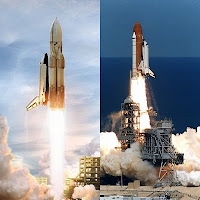
2, respectively.Īll of Angara’s launches thus far have taken place from Russia’s Plesetsk Cosmodrome, but Russia also plans to launch the Angara family of rockets from the Vostochny Cosmodrome. 3 and that Kosmos-25 were deployed into similar orbits with similar levels of mystery surrounding their launches, it is likely that Kosmos-25 are actually EO MKA No. Based on reports that Kosmos-2560 is EO MKA No. 2021, and Kosmos-2555, launched on the first flight of the year. Kosmos-2560 is associated with two previously launched satellites: Kosmos-2551, which was launched aboard a Soyuz-2.1v rocket in Sept.
#Russian space shuttle flight series#
The payload was initially suspected to be a small military optical reconnaissance satellite designated EMKA-3, but post-launch reports suggest that the payload is part of a different series of satellites and is designated EO MKA No. This second launch of the year launched a mystery payload as well, being designated Kosmos-2560 after reaching orbit. Those satellites were deployed in an orbit slightly different than planned and ultimately failed to establish communications with ground stations.Īngara’s second flight of the year, also an Angara 1.2, launched on Oct. The satellite, believed to be MKA-R at launch, shared a naming scheme and satellite bus with two 6U CubeSats, MKA-N 1 & 2, which were previously launched on a rideshare mission aboard a Soyuz-2.1a in July of 2017. While there were multiple possibilities for what the payload onboard was, the most likely was a radar satellite intended for use by the Russian military. Not much is known about the payload, with the only concrete fact being the payload was designated Kosmos-2555 after successfully reaching orbit.

The first Angara flight of the year, an Angara 1.2, launched a mystery payload to orbit on April 29, 2022. Compared to 2021, when Soyuz launched 22 times, launching 11 commercial payloads, this marks a turn in the international launch market which Soyuz once held a grasp on. In the new year, Russia plans to launch its first probe to the Moon since 1976, debut a new member of the Soyuz rocket family, and launch the new Soyuz GVK resupply spacecraft to the International Space Station (ISS).Ģ022 proved to be a slow year for the Russian launch cadence, with one Proton-M launch, two launches of the new Angara rocket, and 19 launches of the Soyuz rocket.


 0 kommentar(er)
0 kommentar(er)
